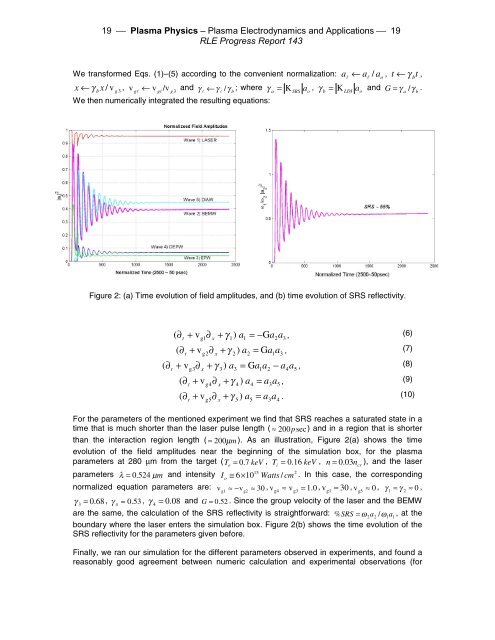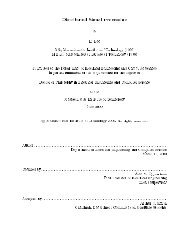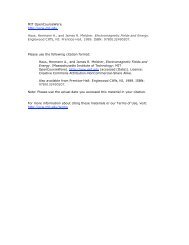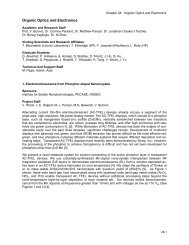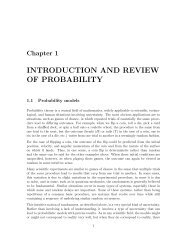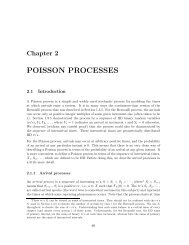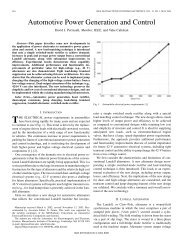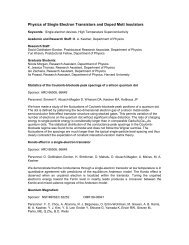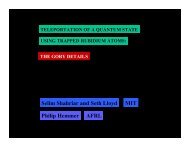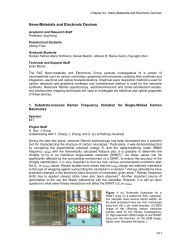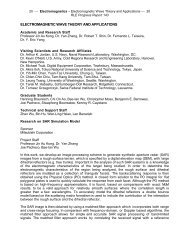RLE Progress Report No - Research Laboratory of Electronics - MIT
RLE Progress Report No - Research Laboratory of Electronics - MIT
RLE Progress Report No - Research Laboratory of Electronics - MIT
You also want an ePaper? Increase the reach of your titles
YUMPU automatically turns print PDFs into web optimized ePapers that Google loves.
We transformed Eqs. (1)–(5) according to the convenient normalization: a<br />
<br />
← a<br />
/ ao<br />
, t ← γ<br />
bt<br />
,<br />
x ← γ b<br />
x / v ,<br />
g 3<br />
v ← v /v and g g<br />
g3<br />
γ<br />
<br />
← γ<br />
<br />
/ γ ; where<br />
b<br />
γ<br />
a<br />
= K<br />
SRS<br />
a ,<br />
o<br />
γ b = K<br />
LDI<br />
a and<br />
o G = γ<br />
a<br />
/ γ .<br />
b<br />
We then numerically integrated the resulting equations:<br />
Figure 2: (a) Time evolution <strong>of</strong> field amplitudes, and (b) time evolution <strong>of</strong> SRS reflectivity.<br />
( ∂ + v ∂ + γ ) a = −Ga<br />
a , (6)<br />
t g1<br />
x 1 1<br />
t<br />
+ vg2∂<br />
x<br />
+ 2<br />
) a2<br />
=<br />
1<br />
2<br />
3<br />
3<br />
( ∂ γ Ga<br />
a , (7)<br />
( ∂ + v ∂ + γ ) a = Ga<br />
a − a a , (8)<br />
t<br />
g3<br />
x 3 3 1<br />
t<br />
+ v g 4∂<br />
x<br />
+ 4<br />
) a4<br />
=<br />
t<br />
+ v g 5∂<br />
x<br />
+ 5)<br />
a5<br />
=<br />
2<br />
3<br />
5<br />
4<br />
5<br />
( ∂ γ a a , (9)<br />
( ∂ γ a a . (10)<br />
3<br />
4<br />
For the parameters <strong>of</strong> the mentioned experiment we find that SRS reaches a saturated state in a<br />
time that is much shorter than the laser pulse length ( ≈ 200psec) and in a region that is shorter<br />
than the interaction region length ( ≈ 200µ m ). As an illustration, Figure 2(a) shows the time<br />
evolution <strong>of</strong> the field amplitudes near the beginning <strong>of</strong> the simulation box, for the plasma<br />
parameters at 280 µm from the target ( T e = 0. 7 keV , T i<br />
= 0. 16 keV , n = 0. 03n ), and the laser<br />
cr<br />
15<br />
2<br />
parameters λ = 0. 524 µ m and intensity I o<br />
≅ 6×<br />
10 Watts / cm . In this case, the corresponding<br />
normalized equation parameters are: v ≈ −v<br />
≈ 30 , v ≈ v 1. 0 , v g1<br />
≈ 30 , v g5<br />
≈ 0, γ ≈ γ 0 ,<br />
g1<br />
g2<br />
g4 g3<br />
=<br />
1 2<br />
≈<br />
γ<br />
3<br />
= 0.68, γ 4 = 0. 53, γ 4 = 0. 08 and G = 0. 52 . Since the group velocity <strong>of</strong> the laser and the BEMW<br />
are the same, the calculation <strong>of</strong> the SRS reflectivity is straightforward: % SRS = ω 2<br />
a2<br />
/ ω1a<br />
, at the<br />
1<br />
boundary where the laser enters the simulation box. Figure 2(b) shows the time evolution <strong>of</strong> the<br />
SRS reflectivity for the parameters given before.<br />
Finally, we ran our simulation for the different parameters observed in experiments, and found a<br />
reasonably good agreement between numeric calculation and experimental observations (for


